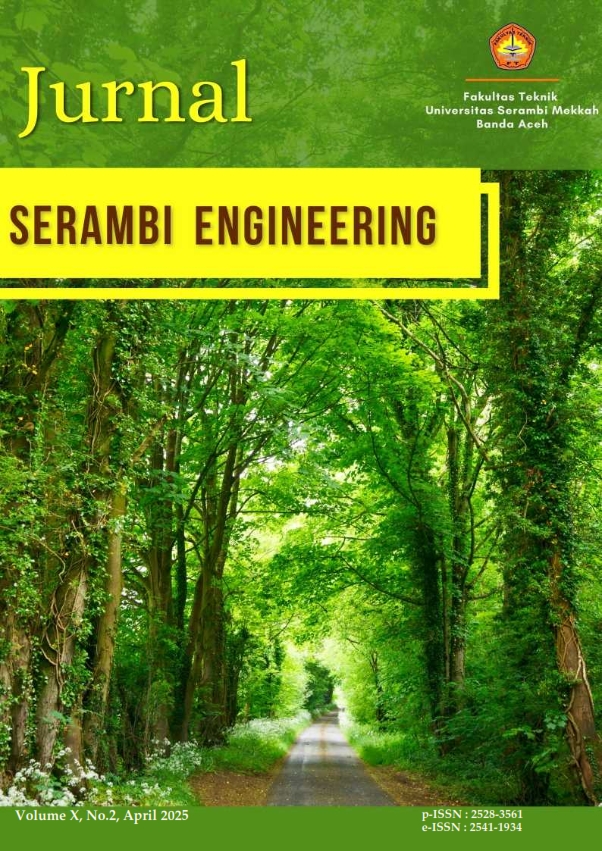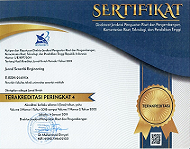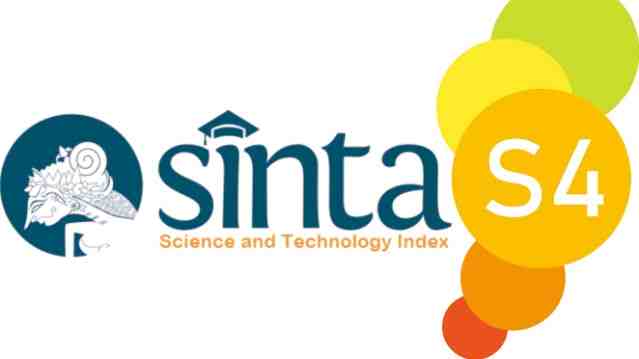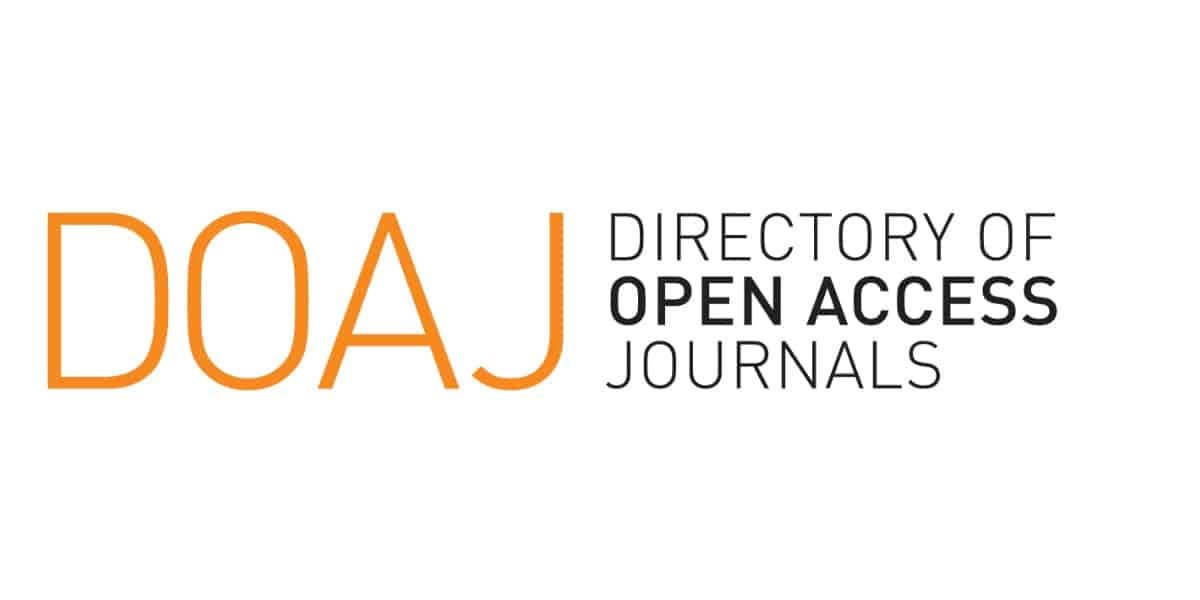Analisis Komposisi Sedimen di Unit Pengolahan Limbah Kota Padang
Keywords:
environmental parameter, sediment, sewage treatment plantAbstract
The purpose of this study is to identify factors that affect environmental parameters in sediments and their impact on sewage treatment plant in Padang city in order to become a basic scientific reference in effective and sustainable water resources management. The measurements were carried out at 5 artificial system locations, namely the Rubber Factory Wastewater Treatment Plant (WWTP), Tofu Factory wastewater drainage, WWTP of Teaching Hospital Andalas University, Fecal Sludge Treatment Plant, and Leachate Treatment Plant at the Air Dingin of Landfill in Padang City, West Sumatra. The measured water parameters are pH, temperature, and salinity, while the measured sediments are nitrite and nitrate. Analysis of environmental parameters in the waters were temperature (30 - 34°C), pH (5.5 - 6.8), and salinity (0 ± 0.4 ppt). The results obtained in the sediment were nitrite (0.63 - 153.58 mg/L), and nitrate (19.28 - 50.01mg/L). Factors that affect water and sediment parameters are biological activity and anthropogenic contaminants. One of the causes of high concentrations of environmental parameters in sediments is the ability of sediments to accumulate and absorb particles and chemicals.
References
Abhradeep Majumder, Ashok Kumar Gupta, Partha Sarathi Ghosal, M. V. (2020). A review on hospital wastewater treatment : A special emphasis on occurrence and removal of pharmaceutically active compounds , resistant microorganisms , and SARS-CoV-2. Journal of Environmental Chemical Engineering, January.
Almufid, A., & Rully, P. (2020). Perencanaan Instalasi Pengolahan Air Limbah (IPAL) Sudi Kasus Proyek IPAL PT.Sumber Masanda Jaya di Kabupaten Brebes Profinsi Jawa Tengah Kapasitas 250 m2 / Hari. Jurnal Teknik, 9(1), 92–100. https://doi.org/10.31000/jt.v9i1.2868
Arisa, R. P. R., Kushartono, E. W., & Atmodjo, W. (2014). Sebaran sedimen dan kandungan bahan organik pada sedimen dasar Perairan Pantai Slamaran Pekalongan. Journal of Marine Research, 3(3), 342–350.
Barus, B. S., Munthe, R. Y., & Bernando, M. (2020). Kandungan Karbon Organik Total dan Fosfat pada Sedimen di Perairan Muara Sungai Banyuasin, Sumatera Selatan. Jurnal Ilmu Dan Teknologi Kelautan Tropis, 12(2), 397–408. https://doi.org/10.29244/jitkt.v12i2.28211
Bird, E. L., Ige, J. O., Pilkington, P., Pinto, A., Petrokofsky, C., & Burgess-Allen, J. (2018). Built and natural environment planning principles for promoting health: An umbrella review. BMC Public Health, 18(1), 1–14. https://doi.org/10.1186/s12889-018-5870-2
Blackburne, R., Vadivelu, V. M., Yuan, Z., & Keller, J. (2007). Kinetic characterisation of an enriched Nitrospira culture with comparison to Nitrobacter. Water Research, 41(14), 3033–3042. https://doi.org/10.1016/j.watres.2007.01.043
Chao, Y., Mao, Y., Yu, K., & Zhang, T. (2016). Novel nitrifiers and comammox in a full-scale hybrid biofilm and activated sludge reactor revealed by metagenomic approach. Applied Microbiology and Biotechnology, 100(18), 8225–8237. https://doi.org/10.1007/s00253-016-7655-9
Da Silva, G., Kennedy, E. M., & Dlugogorski, B. Z. (2006). Ab initio procedure for aqueous-phase pKa calculation: The acidity of nitrous acid. Journal of Physical Chemistry A, 110(39), 11371–11376. https://doi.org/10.1021/jp0639243
Daebeler, A., Güell-Bujons, Q., Mooshammer, M., Zechmeister, T., Herbold, C. W., Richter, A., Wagner, M., & Daims, H. (2023). Rapid nitrification involving comammox and canonical Nitrospira at extreme pH in saline-alkaline lakes. Environmental Microbiology, 25(5), 1055–1067. https://doi.org/10.1111/1462-2920.16337
Daims, H., Lebedeva, E. V., Pjevac, P., Han, P., Herbold, C., Albertsen, M., Jehmlich, N., Palatinszky, M., Vierheilig, J., Bulaev, A., Kirkegaard, R. H., Von Bergen, M., Rattei, T., Bendinger, B., Nielsen, P. H., & Wagner, M. (2015). Complete nitrification by Nitrospira bacteria. Nature, 528(7583), 504–509. https://doi.org/10.1038/nature16461
De Boer, W., & Kowalchuk, G. A. (2001). Nitrification in acid soils: Micro-organisms and mechanisms. Soil Biology and Biochemistry, 33(7–8), 853–866. https://doi.org/10.1016/S0038-0717(00)00247-9
Fitriani, D., Utami, W., Kirana, K. H., Agustine, E., & Zulaikah, S. (2021). Magnetic Signatures on River Sediments and Agricultural Soils as Proxy Indicators of Anthropogenic-derived Pollution (Case Study: Cikijing River, Rancaekek, West Java). Jurnal Penelitian Pendidikan IPA, 7(3), 381–387. https://doi.org/10.29303/jppipa.v7i3.697
Grunditz, C., & Dalhammar, G. (2001). Development of nitrification inhibition assays using pure cultures of Nitrosomonas and Nitrobacter. Water Research, 35(2), 433–440. https://doi.org/10.1016/S0043-1354(00)00312-2
Gubry-Rangin, C., Hai, B., Quince, C., Engel, M., Thomson, B. C., James, P., Schloter, M., Griffiths, R. I., Prosser, J. I., & Nicol, G. W. (2011). Niche specialization of terrestrial archaeal ammonia oxidizers. Proceedings of the National Academy of Sciences of the United States of America, 108(52), 21206–21211. https://doi.org/10.1073/pnas.1109000108
Hu, H. W., & He, J. Z. (2017). Comammox—a newly discovered nitrification process in the terrestrial nitrogen cycle. In Journal of Soils and Sediments (Vol. 17, Issue 12, pp. 2709–2717). Springer Verlag. https://doi.org/10.1007/s11368-017-1851-9
Ikhfini Munawaroh, Hamdani Dwi Prasetyo, H. L. (2023). Evaluasi Kadar Oksigen Terlarut, Nitrat, dan Nitrit Pada Kolam Wetland Dengan Tanaman Tasbih (Canna indica) Di Instalasi Pengolahan Limbah Tinja (IPLT) Supit Urang - Kota Malang. Journal of Science and Technology, September.
Jan-Michael Blum, Qingxian Su, Yunjie Ma,Borja Valverde-Pierez, Carlos Domingo-Fielez, M. M. J. B. F. S. (2018). The pH dependency of N-converting enzymaticprocesses, pathways and microbes: effecton net N2O production.
Jhuma, M. (2016). Environment In Context : A Perspective From Environment Behavior Relation. International Journal of Humanities and Social Science Invention, 5(3), 37–43.
Koch, H., van Kessel, M. A. H. J., & Lücker, S. (2019). Complete nitrification: insights into the ecophysiology of comammox Nitrospira. Applied Microbiology and Biotechnology, 103(1), 177–189. https://doi.org/10.1007/s00253-018-9486-3
Koda, E., Miszkowska, A., & Sieczka, A. (2017). Levels of organic pollution indicators in groundwater at the old landfill and waste management site. Applied Sciences (Switzerland), 7(6). https://doi.org/10.3390/app7060638
Kuypers, M. M. M. (2017). Microbiology: A fight for scraps of ammonia. Nature, 549(7671), 162–163. http://www.nature.com/doifinder/10.1038/549162a
Lawson, C. E., & Lücker, S. (2018). Complete ammonia oxidation: an important control on nitrification in engineered ecosystems? Current Opinion in Biotechnology, 50, 158–165. https://doi.org/10.1016/j.copbio.2018.01.015
Liu, S., Wang, H., Chen, L., Wang, J., Zheng, M., Liu, S., Chen, Q., & Ni, J. (2020). Comammox Nitrospira within the Yangtze River continuum: community, biogeography, and ecological drivers. ISME Journal, 14(10), 2488–2504. https://doi.org/10.1038/s41396-020-0701-8
Luo, S., Peng, Y., Liu, Y., & Peng, Y. (2022). Research progress and prospects of complete ammonia oxidizing bacteria in wastewater treatment. Frontiers of Environmental Science and Engineering, 16(9). https://doi.org/10.1007/s11783-022-1555-2
Mehrani, M. J., Sobotka, D., Kowal, P., Ciesielski, S., & Makinia, J. (2020). The occurrence and role of Nitrospira in nitrogen removal systems. Bioresource Technology, 303. https://doi.org/10.1016/j.biortech.2020.122936
Mehrani, M. J., Sobotka, D., Kowal, P., Guo, J., & Mąkinia, J. (2022). New insights into modeling two-step nitrification in activated sludge systems – The effects of initial biomass concentrations, comammox and heterotrophic activities. Science of the Total Environment, 848(April). https://doi.org/10.1016/j.scitotenv.2022.157628
Morimoto, S., Hayatsu, M., Hoshino, Y. T., Nagaoka, K., Yamazaki, M., Karasawa, T., Takenaka, M., & Akiyama, H. (2011). Quantitative analyses of ammonia-oxidizing archaea (AOA) and ammonia-oxidizing bacteria (AOB) in fields with different soil types. Microbes and Environments, 26(3), 248–253. https://doi.org/10.1264/jsme2.ME11127
Mota, M., Rodríguez, R., Solanas, E., & Fondevila, M. (2005). Evaluation of four tropical browse legumes as nitrogen sources: Comparison of in vitro gas production with other methods to determine N degradability. Animal Feed Science and Technology, 123-124 Pa, 341–350. https://doi.org/10.1016/j.anifeedsci.2005.04.018
Pariente, M. I., Segura, Y., Álvarez-Torrellas, S., Casas, J. A., de Pedro, Z. M., Diaz, E., García, J., López-Muñoz, M. J., Marugán, J., Mohedano, A. F., Molina, R., Munoz, M., Pablos, C., Perdigón-Melón, J. A., Petre, A. L., Rodríguez, J. J., Tobajas, M., & Martínez, F. (2022). Critical review of technologies for the on-site treatment of hospital wastewater: From conventional to combined advanced processes. Journal of Environmental Management, 320(August). https://doi.org/10.1016/j.jenvman.2022.115769
Pratiwi, R. K., Mahmudi, M., Faqih, A. R., & Arfiati, D. (2023). Dynamics of Water Quality for Vannamei Shrimp Cultivation in Intensive Ponds in Coastal Areas. Jurnal Penelitian Pendidikan IPA, 9(10), 8656–8664. https://doi.org/10.29303/jppipa.v9i10.4322
Pudjowati, J., Ayu, N., Wulandari, N. S., Dwi, A., Zahirah, A., Febriyanti, D., & Prakoso, T. (2024). Pemanfaatan Air Limbah dengan Mengelolah melalui IPAL di Kampung Bhumi Marinir Karang Pilang. JSHI, 8(5), 82–87.
Rohyani, I. S. (2021). The Effect of Microhabitat Diversity on the Similarity of Soil Insect Types at Lombok Island, Indonesia. Jurnal Penelitian Pendidikan IPA, 7(4), 738–745. https://doi.org/10.29303/jppipa.v7i4.807
Santos, J. P., Mendes, D., Monteiro, M., Ribeiro, H., Baptista, M. S., Borges, M. T., & Magalhães, C. (2018). Salinity impact on ammonia oxidizers activity and amoA expression in estuarine sediments. Estuarine, Coastal and Shelf Science, 211, 177–187. https://doi.org/10.1016/j.ecss.2017.09.001
Sepriani, Abidjulu, J., & Kolengan, H. S. (2016). Pengaruh Limbah Cair Industri Tahu Terhadap Kualitas Air Sungai Paal 4 Kecamatan Tikala Kota Manado. Chemistry Progress, 9(1), 29–33.
Shen, J., Zhang, L., Zhu, Y., & Zhang, J. (2008). Abundance and composition of ammonia‐oxidizing bacteria and ammonia‐oxidizing archaea communities of an alkaline sandy loam (pp. 1601–1611).
Shi, X., Hu, H. W., Wang, J., He, J. Z., Zheng, C., Wan, X., & Huang, Z. (2018). Niche separation of comammox Nitrospira and canonical ammonia oxidizers in an acidic subtropical forest soil under long-term nitrogen deposition. Soil Biology and Biochemistry, 126(September), 114–122. https://doi.org/10.1016/j.soilbio.2018.09.004
Shi, Y., Jiang, Y., Wang, S., Wang, X., & Zhu, G. (2020). Biogeographic distribution of comammox bacteria in diverse terrestrial habitats. Science of the Total Environment, 717. https://doi.org/10.1016/j.scitotenv.2020.137257
Sobotka D, Kowal P, Zubrowska Sudoł M, and M. J. (2018). Comammox - a new pathway in the nitrogen cycle in wastewater treatment plants. Journal of Civil Engineering and Environmental Sciences, 4, 031–033. https://doi.org/10.17352/2455-488x.000024
Stevens, B. M., Sonderegger, D. L., & Johnson, N. C. (2022). Microbial community structure across grazing treatments and environmental gradients in the Serengeti. Soil Ecology Letters, 4(1), 45–56. https://doi.org/10.1007/s42832-020-0065-z
Sun, D., Tang, X., Zhao, M., Zhang, Z., Hou, L., Liu, M., Wang, B., Klümper, U., & Han, P. (2020a). Distribution and Diversity of Comammox Nitrospira in Coastal Wetlands of China. Frontiers in Microbiology, 11. https://doi.org/10.3389/fmicb.2020.589268
Sun, D., Tang, X., Zhao, M., Zhang, Z., Hou, L., Liu, M., Wang, B., Klümper, U., & Han, P. (2020b). Distribution and Diversity of Comammox Nitrospira in Coastal Wetlands of China. Frontiers in Microbiology, 11(October), 1–13. https://doi.org/10.3389/fmicb.2020.589268
Sun, P., Zhang, S., Wu, Q., Zhu, P., Ruan, Y., & Wang, Q. (2021). pH and ammonium concentration are dominant predictors of the abundance and community composition of comammox bacteria in long-term fertilized Mollisol. Applied Soil Ecology, 168(March). https://doi.org/10.1016/j.apsoil.2021.104139
Supardiono, S., Rahayu, R. N., Isrowati, I., & Ernawati, E. (2023). Analysis of Water Quality in The Srigangga River Flow, Central Lombok. Jurnal Penelitian Pendidikan IPA, 9(SpecialIssue), 254–259. https://doi.org/10.29303/jppipa.v9ispecialissue.6394
Takahashi, Y., Fujitani, H., Hirono, Y., Tago, K., Wang, Y., Hayatsu, M., & Tsuneda, S. (2020). Enrichment of Comammox and Nitrite-Oxidizing Nitrospira From Acidic Soils. Frontiers in Microbiology, 11(July), 1–17. https://doi.org/10.3389/fmicb.2020.01737
Van Kessel, M. A. H. J., Speth, D. R., Albertsen, M., Nielsen, P. H., Op Den Camp, H. J. M., Kartal, B., Jetten, M. S. M., & Lücker, S. (2015). Complete nitrification by a single microorganism. Nature, 528(7583), 555–559. https://doi.org/10.1038/nature16459
Yang, X., Wu, Y., Shu, L., Gu, H., Liu, F., Ding, J., Zeng, J., Wang, C., He, Z., Xu, M., Liu, F., Zheng, X., & Wu, B. (2024). Unraveling the important role of comammox Nitrospira to nitrification in the coastal aquaculture system. Frontiers in Microbiology, 15(April), 1–13. https://doi.org/10.3389/fmicb.2024.1355859
Zhang, M., Huang, J. C., Sun, S., Rehman, M. M. U., He, S., & Zhou, W. (2021). Nitrogen removal through collaborative microbial pathways in tidal flow constructed wetlands. Science of the Total Environment, 758(xxxx), 143594. https://doi.org/10.1016/j.scitotenv.2020.143594
Zhang, Y., Ma, H., Chen, R., Niu, Q., & Li, Y. Y. (2018). Stoichiometric variation and loading capacity of a high-loading anammox attached film expanded bed (AAEEB) reactor. Bioresource Technology, 253, 130–140. https://doi.org/10.1016/j.biortech.2018.01.043
Zheng, M., Tian, Z., Chai, Z., Zhang, A., Gu, A., Mu, G., Wu, D., & Guo, J. (2023). Ubiquitous occurrence and functional dominance of comammox Nitrospira in full-scale wastewater treatment plants. Water Research, 236(March). https://doi.org/10.1016/j.watres.2023.119931
Downloads
Published
Issue
Section
License
Copyright (c) 2025 Sodaya Ummi, Zulkarnaini, Shinta Indah (Author)

This work is licensed under a Creative Commons Attribution 4.0 International License.

















